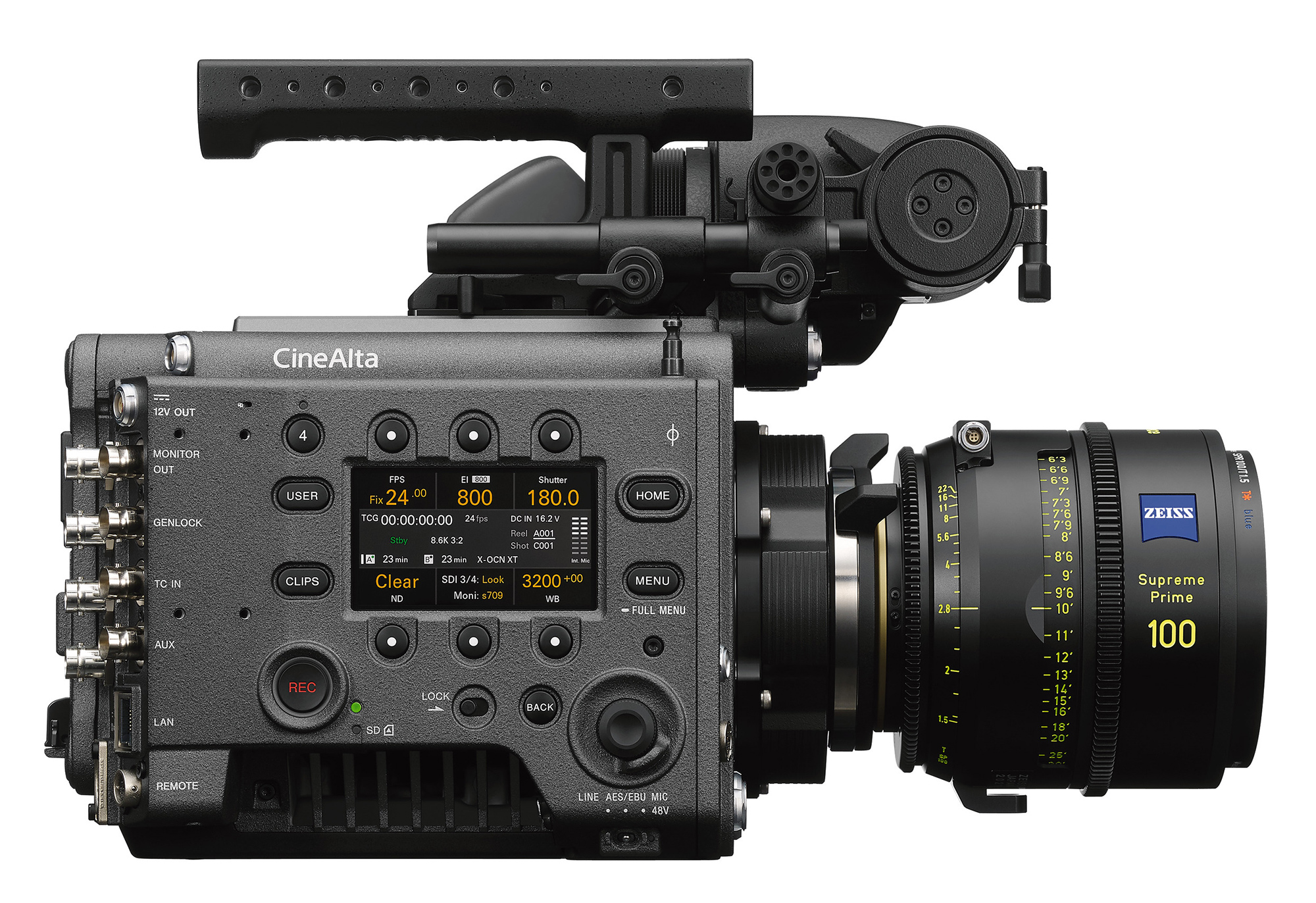
At the top of the new camera’s feature list is a completely new full frame 8K (8640 x 5760, so actually 8.6K) resolution sensor with improved dynamic range (16 stops according to Sony), as well as internal recording to AXS media. That’s right, the AXS-R7 RAW Recorder is no longer needed with the new camera – two internal AXSM card slots have replaced the SxS slots on the original VENICE body.
The new 8K sensor version packs nearly 50MP, doubling the existing 6K sensor’s resolution. Available recording modes include a 3:2 aspect ratio full frame mode, 8.2K 17:9 and 7.6K 16:9 modes, as well as a 5.8K 6:5 mode for (near) full-frame anamorphic shooting. The Super35 “crop” of the new sensor pencils out to 5.8K, for a 17:9 DCI full container frame, or 5.4K in UHD 16:9. Additional modes, particularly those allowing a 4K or UHD file straight from the camera, will be available in future firmware upgrades.
In the full frame sensor mode, the new camera can record up to 30fps, and when dropping down the “best fit” 8.2K 17:9 and 7.6K 16:9 modes record up to 60fps. In the 5.8K and 5.4K Super35 modes, the frame rate maxes out at 90fps. The 5.8K 6:5 mode, tailored to anamorphic shooting, can achieve 48fps. For the 6K sensor version, the recording modes and frame rates mirror those available in the original VENICE as of firmware version 6.0.
For the frame rates in excess of 60fps, there is no high frame rate license needed for either version of the VENICE 2. However, full frame and anamorphic licenses are still required to take advantage of those features.
To record X-OCN, Sony’s variable compression RAW codec introduced with the R7 recorder, at these higher resolutions, new faster “S66” cards are required, boasting a maximum write speed of 6.6 Gbps. The existing “flavors” of X-OCN remain, with XT providing the highest bit rate/least compression and the ST and LT versions providing 30% and 60% smaller files respectively.
At launch, internal ProRes recording to AXS cards will be in 4K ProRes 4444 or 422HQ, oversampled and scaled down from the 8K or 6K sensor modes (or recorded without oversampling using the 6K version’s Super35 4K recording mode). No simultaneous recording of multiple formats will be available in the new camera. However, the original VENICE body with XAVC 4K recording, ProRes HD recording, and simultaneous recording will remain an active member of Sony’s lineup. ProRes 4444 XQ is said to be planned as an addition to the new camera in a future firmware update.
MODULAR DESIGN
The new camera body is visually nearly identical to the original VENICE; although it is slightly heavier (9.25 lbs. and 9.03 lbs. for the 8K and 6K versions, compared with 8.59 lbs for the original VENICE) and longer (16mm). However, since the AXS-R7 RAW Recorder is no longer required for X-OCN recording, the new body can be thought of as ~44mm shorter overall than the combination of an original VENICE and AXS-R7 module.
It’s important to note that the new sensor blocks are interchangeable. No firmware re-installation or other maintenance is required to swap between the 6K and 8K sensor blocks for VENICE 2 (although they will be sold as two distinct versions of the camera). The existing built-in ND filters remain as on the original VENICE.
Other new or changed features on the body include improved airflow and cooling, so that the camera runs cooler overall, as well as the addition of more active cooling for the 8K version. A scratch mic has been added to the AC side upper, between the new 2-pin 12v Lemo power output (which replaces the 4-pin 12v Hirose on the original VENICE) and assignable button 4. Adjacent to this area are new M3 screw threads to allow rental houses and owner-operators to brand the camera with their logo or other identifying information.
On the rear of the body, the RJ-45 ethernet jack has been moved from the operator side lower to below the Aux/Timecode Out BNC connector. On the operator side, there is a new air vent in place of the ethernet jack dedicated to the AXSM media subsystem.
The existing VENICE Extension System, better known by its codename Rialto, will be updated to a new version for VENICE 2 with higher bandwidth cabling to accommodate the increased data rate from the new sensor.
Stay tuned this blog for more information about this major new entry into the digital cinema camera market from Sony. You can also visit the Sony Cine official site for more VENICE 2 information and videos, or contact our sales team today.




